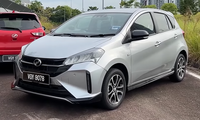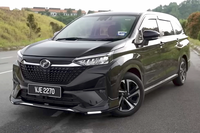
Proton Holdings Berhad, commonly known as Proton, is a Malaysian multinational automotive company. Proton was established on 7 May 1983, as Malaysia's sole national budget car company until the advent of Perodua in 1993. The company is headquartered in Shah Alam, Selangor, and operates additional facilities in Proton City, Perak.

Daihatsu Motor Co., Ltd. is a Japanese automobile manufacturer headquartered in Ikeda, Osaka Prefecture, Japan.
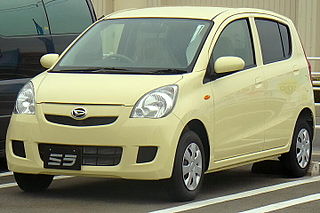
The Daihatsu Mira is a kei-type city car built by Japanese car maker Daihatsu. It has a variety of options and chassis variations, with the latest variant having four models: Mira, Mira AVY, Mira Gino, and Mira VAN. The Mira is the latest successor to the line of cars begun with the Daihatsu Fellow of 1966, and was originally introduced as the commercial version of the Cuore. Outside of Japan, the Mira has also been offered with larger 850 or 1000-cc engines. In Australia, the two-seater version was marketed as the Daihatsu Handivan and later as the Daihatsu Handi. The term mira means "to see" in Spanish and "goal" or "purpose" in Latin.

The Daihatsu Terios is a mini SUV produced by the Japanese automobile manufacturer Daihatsu since 1997 as the successor to the F300 series Rocky. It was initially offered in both short- and long-wheelbase configurations before the former stopped production in 2016 to be replaced by the A200 series Rocky crossover in 2019. The long-wheelbase variant is available mainly for the Indonesian market with three-row seating options. A smaller kei car model called the Terios Kid/Lucia was also available for the first-generation model.

The Proton Saga is a series of subcompact cars and currently city cars produced by Malaysian automobile manufacturer Proton. Introduced in 1985, the Proton Saga became the first Malaysian car and a major milestone in the Malaysian automotive industry. The Saga is Proton's longest-running and best-selling nameplate, with over 1.9 million units sold worldwide over 37 years.

The Perodua Kelisa is a city car from Malaysian automaker Perodua. It was launched in 2001 as the successor to the Perodua Kancil. The Kelisa was sold alongside the older Kancil, and both were eventually replaced by the Perodua Viva in 2007.
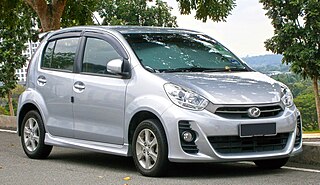
The Perodua Myvi is a subcompact car/supermini (B-segment) produced by the Malaysian manufacturer Perodua since 2005. Based on the Daihatsu Boon, the Myvi is the result of Perodua's collaboration with both Toyota and Daihatsu. However, the third generation Myvi was entirely designed and made in Malaysia, thus not being based on the third generation Boon. The Myvi was the best-selling car in Malaysia for nine consecutive years, between 2006 and 2014, and again between the years 2018 and 2022. The Myvi has been Malaysia's best-selling car for 14 years since its first full year of sales in 2006. As of 2023, the Myvi reached 1.4 million units sold since the launch of its first generation in 2005.

The Perodua Kancil is a city car manufactured by Malaysian automobile manufacturer Perodua from August 1994 to July 2009. The Kancil is a rebadged third generation Daihatsu Mira.

The Perodua Rusa is a cab over microvan manufactured by the Malaysian automaker Perodua between 1996 and 2007, and based on the Daihatsu Zebra. Launched on March 6, 1996, the Rusa is the first van model to be produced by a Malaysian automotive company. The original model received a 1.3-litre engine, complemented by a 1.6-litre model in May 1997.

Sime UMW Berhad is a Malaysian industrial conglomerate. It is one of the largest companies and also one of the leading industrial enterprises, serving the economies of Malaysia and the Asia-Pacific region. On 13 December 2023, it was announced that Sime Darby completed its acquisition of the majority stake (61.2%) in the company. Following Sime Darby's rebranding exercise to become simply Sime in November 2024, UMW Holdings rebranded as Sime UMW.

The Perodua Viva is a city car manufactured by Malaysian automaker Perodua since 10 May 2007. At launch, Perodua marketed the Viva as a Kelisa replacement only. Later in the Viva's life, with the introduction of the 660 BX variant, the Viva finally replaced the Kancil. The Perodua Viva is based on the sixth generation Daihatsu Mira (L250). The name "Viva" is derived from the Italian word viva, meaning "long live".

The Proton Exora is a discontinued automobile produced by the Malaysian car manufacturer Proton. Considered to be a compact multi-purpose vehicle (MPV) in the C-segment, it became Malaysia's first locally developed MPV upon its release on April 15, 2009. The Exora is the first Proton based on the P2 platform. Its facelift revision, which debuted on December 15, 2011, became the first Proton to use the CamPro CFE turbocharged engine and CVT technology.

The M500 series Perodua Alza is the first generation of Alza B-segment multi-purpose vehicle (MPV) produced by Malaysian car manufacturer Perodua. Based on the Daihatsu Boon Luminas, it was launched in November 2009 as the company's first purpose-built MPV.

The Daihatsu E-series engine is a range of compact three-cylinder, internal combustion piston engines, designed by Daihatsu, which is a subsidiary of Toyota. The petrol-driven series has cast iron engine blocks and aluminum cylinder heads, and are of either SOHC or DOHC design, with belt driven heads.

The first generation Proton Saga was the first automobile produced by Malaysian automobile manufacturer, Proton. It was based on the 1983 Mitsubishi Lancer Fiore as a result of a joint venture between HICOM and Mitsubishi. The Proton Saga was officially launched on 9 July 1985 by the fourth prime minister, Dr. Mahathir Mohamad. It was produced in both 4-door saloon and 5-door hatchback styles.

The Perodua Axia is a city car produced by Malaysian automobile manufacturer Perodua. It was launched on 15 September 2014 as the successor to the Viva. The car takes over the title of being the most affordable car in Malaysia from the Viva, and the best-selling car in Malaysia for three consecutive years, between 2015 until 2017. The Axia is the first model to debut from Perodua's all-new second factory in Rawang, Selangor. As of mid-2023, the Axia reached 600,000 units sold since the launch of its first generation in 2014.
The automotive industry in Malaysia consists of 27 vehicle producers and over 640 component manufacturers. The Malaysian automotive industry is the third largest in Southeast Asia, and the 23rd largest in the world, with an annual production output of over 500,000 vehicles. The automotive industry contributes 4% or RM 40 billion to Malaysia's GDP, and employs a workforce of over 700,000 throughout a nationwide ecosystem.
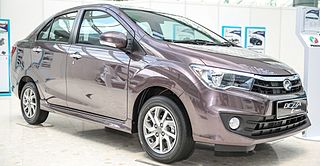
The Perodua Bezza is an A-segment sedan produced by Malaysian automobile manufacturer Perodua. It was launched on 21 July 2016 as Perodua's first sedan car, and a complement to the Axia hatchback.
Perusahaan Otomobil Elektrik (Malaysia) Sdn. Bhd. (POEM) is the name of a defunct Malaysian company that produced small electric vehicles in the late 1990s and early 2000s. POEM was established in 1996 as a joint venture between Tenaga Nasional and Frazer-Nash Research. The first POEM vehicle, the Eleksuria was touted as Malaysia's first electric vehicle upon its launch in December 1997.

The A200/A250 seriesDaihatsu Rocky is a subcompact crossover SUV manufactured by Daihatsu. It was unveiled at the 46th Tokyo Motor Show on 23 October 2019 under the "New Compact SUV" name. It replaced the Be‣go in the Japanese market and went on sale on 5 November 2019. The Rocky is also rebadged and sold under Toyota and Subaru brands as the Toyota Raize and Subaru Rex respectively.



